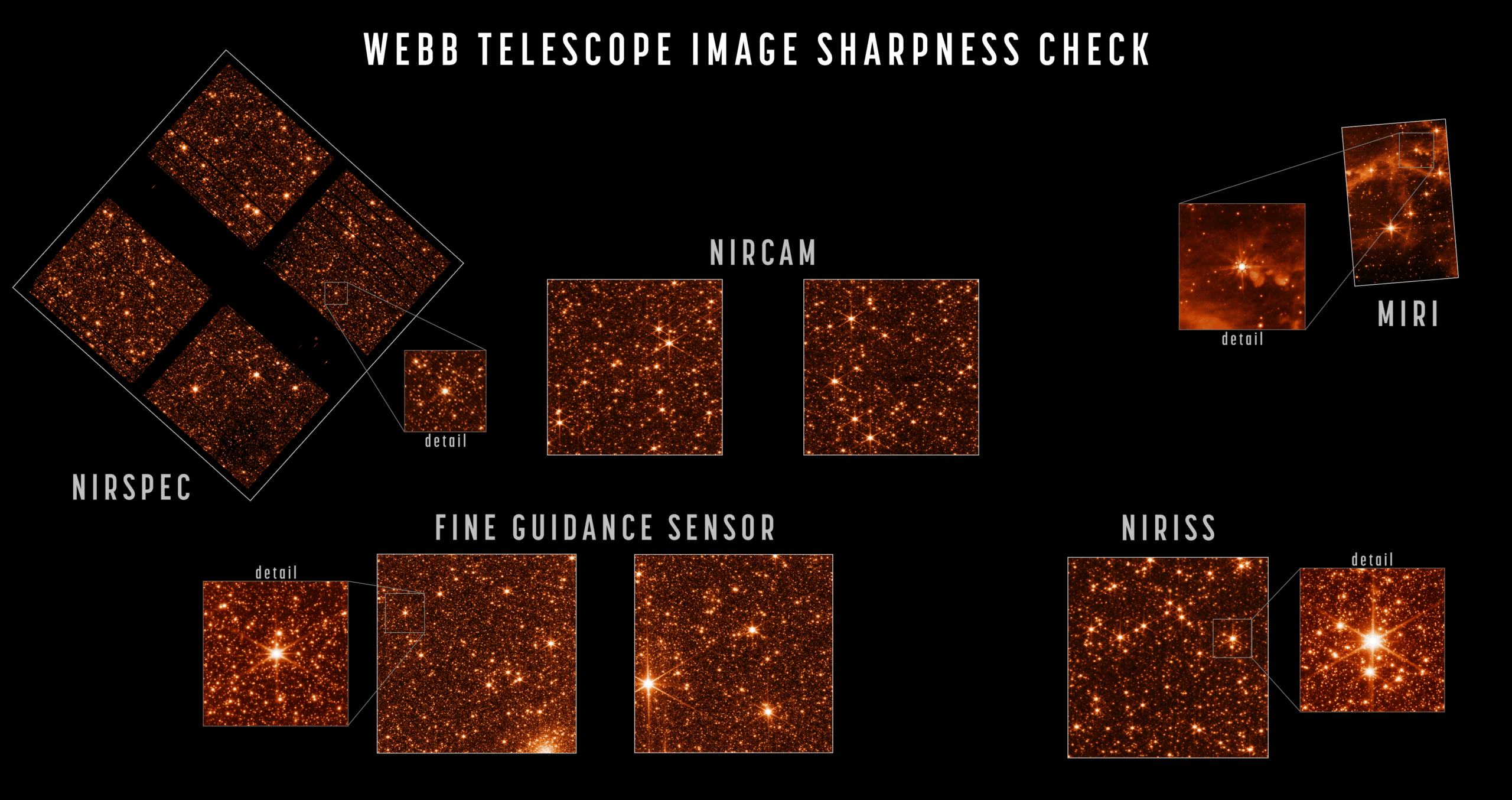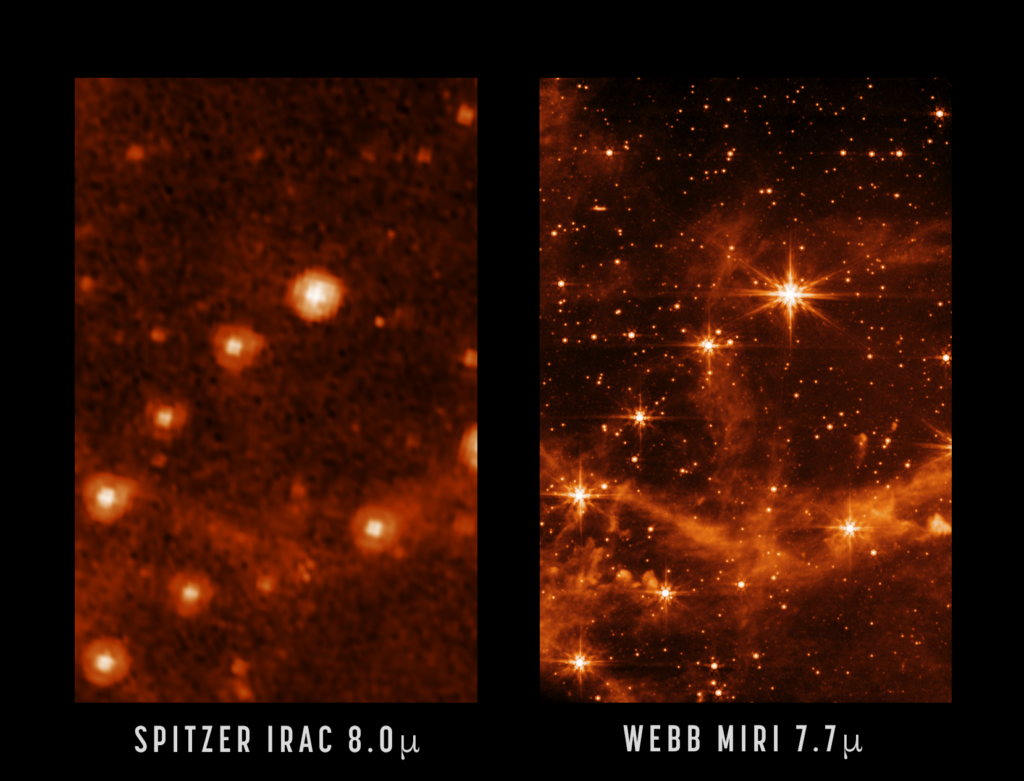On May 9, NASA held a media conference call to discuss progress in preparing the James Webb Space Telescope for science operations. The program manager revealed that the telescope should provide its first images in mid-July. These shots, which should be spectacular, are eagerly awaited by all researchers. In the meantime, some images from shots captured during the mirror alignment phase have been published.
The James Webb Space Telescope needs no introduction. Launched last December, the 10 billion US dollar machine is the largest and most powerful astronomical observatory ever sent into space. Its objective is to collect the light emitted by the first stars and galaxies nearly 14 billion years ago, while watching for possible signs of life. For now, scientists are keeping the identity of Webb’s first official target secret. Located 1.6 million kilometers from Earth, Webb is considered the successor to the aging Hubble Space Telescope, although its observations will mostly be of a different nature.
Thus, the James Webb telescope has just completed its mirror alignment phase. After a comprehensive review, it has been confirmed that the observatory is now capable of capturing sharp, well-focused images, with each of its four powerful science instruments on board. The team held a series of key decision meetings and unanimously agreed that Webb is ready to move on to its next and final round of preparations, dubbed « commissioning the science instruments. » This process will take about two months, before science operations begin this summer.
Unexpected performance
The telescope’s optical performance continues to be better than the engineering team’s most optimistic predictions. Webb’s mirrors now direct fully focused light, collected from space, into each instrument, and each instrument successfully captures images with the light delivered to them. The image quality delivered to all instruments is « diffraction limited », which means that the fineness of visible detail is as good as physically possible, given the size of the telescope. Going forward, as NASA engineers pointed out during the May 9 teleconference, the only changes to the mirrors will be very small, periodic adjustments to the primary mirror segments.
To test the alignment of the mirrors and the various instruments, the scientists pointed the Webb telescope at part of the Large Magellanic Cloud, a small satellite galaxy of the Milky Way, providing a dense field of hundreds of thousands of stars to through all the sensors of the observatory. Indeed, such precise points in the sky, already observed by other telescopes (Hubble or Spitzer), are valuable in the astrometric calibration phases, the project engineers explained on May 9.

The new Webb image sent back to the researchers, finishing the alignment of the 18 mirrors, is surprisingly much more detailed than the previous ones, in particular because it uses the coldest instrument, the Mid-Infrared Instrument (MIRI). The new MIRI image thus reveals the chemistry of interstellar gas in unprecedented detail, including the emission of carbon and hydrogen molecules. The latter, called « polycyclic aromatic hydrocarbons », are considered to be the building blocks of life. When Webb is ready to begin scientific observations, studies like these with MIRI will help provide astronomers with new information about the birth of stars and protoplanetary systems.
Instrument commissioning
Now the team will take about two months to prepare and test the science instruments — the so-called “instrument commissioning” — before the first science images and Webb spectra come out this summer.
Each instrument is a highly sophisticated set of detectors equipped with unique lenses, masks, filters and equipment. The specialized features of these instruments will be configured and operated in various combinations during the instrument commissioning phase to fully confirm their readiness for future missions.
The various instruments, grouped under the name ISIM (Integrated Science Instrument Module), are: (1) a near-infrared camera, or NIRCam — provided by the University of Arizona ; (2) a near infrared spectrograph, or NIRSpec — provided by ESA, with components provided by NASA/GSFC; (3) the Mid-Infrared Instrument, or MIRI — developed by the European Consortium and the European Space Agency (ESA), as well as NASA’s Jet Propulsion Laboratory (JPL); and (4) a Fine Guidance Sensor/Near InfraRed Imager and Slitless Spectrograph, or FGS/NIRISS — provided by the Canadian Space Agency.

As part of commissioning the science instrument, researchers will direct the telescope to point to different areas of the sky, where the total amount of solar radiation hitting the observatory will vary, to confirm thermal stability when changing targets. . In addition, continuous maintenance observations, every two days, will be used to monitor the alignment of the mirrors and, if necessary, apply corrections to keep the mirrors in their aligned locations.
Finally, mission engineers will test Webb’s ability to track objects in the solar system, such as planets, satellites, rings, asteroids and comets. Scientists will focus on making sure Webb can do this properly, given that the observatory is particularly sensitive to light.
While officials have yet to release information on which commissioning target Webb will focus on first when its testing work is complete, they stressed that the observatory remains on schedule to begin its anticipated scientific publication this summer.

